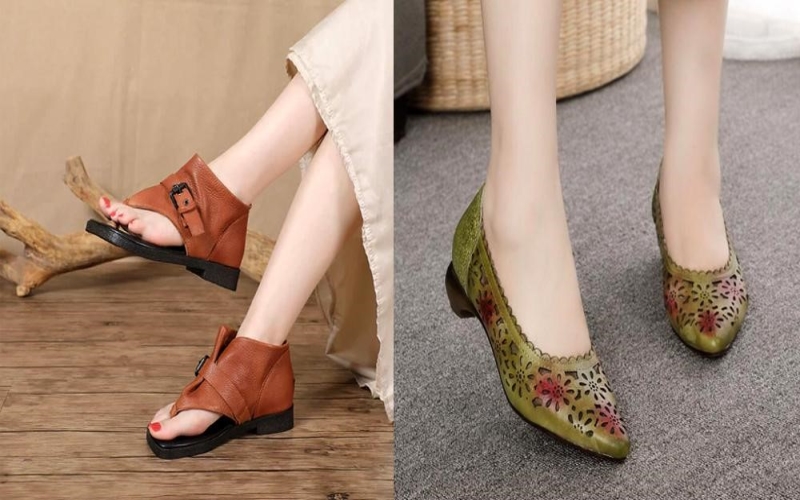Flat Shoes vs. Low Heels: Which is Better for Style and Comfort?
Choosing between flat shoes and low heels impacts your style and comfort, striking a balance between elegance and practicality. Flats offer unparalleled comfort for daily activities, while low heels enhance style without sacrificing ease, making them suitable for both professional and leisure settings.
This article simplifies the complex decision of selecting appropriate footwear by detailing the best types, occasions, and styles for flats and low heels, offering insights to make informed choices.
By following this article, you’ll understand how each shoe type fits various aspects of your lifestyle, learning to combine comfort with style effectively. Embrace a footwear collection that caters to your needs, allowing you to face any situation confidently.
FLAT SHOES: A SYMBOL OF UNPARALLELED COMFORT
Flat shoes stand as a testament to comfort, offering a seamless blend of elegance and practicality that caters to the dynamic needs of daily wear. The flat shoes collection is vast, with options ranging from slip-ons and loafers to moccasins, each with unique charm and functionality.

- Slip-Ons: Known for their low-cut and lace-less design, slip-ons like those from Vans offer a sporty yet smart-casual look, ideal for various occasions, from running errands to casual outings.
- Loafers: Loafers bring a vintage and glamorous touch, making them versatile for casual and semi-formal settings. Their laceless design and comfortable fit make them a staple for any wardrobe.
- Moccasins: These are the epitome of comfort, with their heel-less soles and soft leather construction designed for durability and a snug fit, making them perfect for a laid-back yet stylish look.
Each type of flat shoe features comfort and style, making them indispensable for women who value both ease and elegance in their daily attire.
LOW HEELS: ELEVATING STYLE WITH COMFORT
Low heels are the bridge between the comfort of flats and the sophistication of high heels. They offer a versatile solution with the same style and functionality, suitable for work, casual outings, and even formal events.

- Medium Heels: With heights between three to four inches, medium heels are the quintessential work shoe, offering a boost in posture and style without the discomfort of higher heels.
- Slim Heels: These heels add a touch of elegance and are perfect for dressier occasions, combining the allure of heels with a manageable height.
- Spool Heels: Featuring an hourglass shape, spool heels provide a unique style that echoes European elegance, marrying comfort with a decorative appeal.
Low heels are about finding the sweet spot between height and comfort, allowing for an enhanced confidence without the strain of traditional high heels. Elevate your wardrobe by exploring the full range of low heels at The Best Tailor’s Low Heel Collection, where the perfect balance of elevation and ease awaits. They embody a blend of fashion and practicality, catering to modern women’s need for stylish and wearable shoes throughout the day.
MAKING THE RIGHT CHOICE FOR YOUR FEET
ANALYZING FOOTWEAR NEEDS AND LIFESTYLE
The quest for the perfect shoe often begins with reflecting on one’s lifestyle, work environment, and personal comfort preferences. Each of these elements plays a pivotal role in guiding our footwear choices, ensuring they complement our style and daily activities.
- Lifestyle Considerations: Your day-to-day activities demand footwear that aligns with your lifestyle. Are you constantly on the move, or does your day involve more seated activities? For the active individual, flats or supportive low heels offer the comfort and durability needed. Meanwhile, a more sedentary lifestyle might allow for a wider range of footwear choices without significant comfort compromises.
- Work Environment: The nature of your work environment significantly influences your shoe selection. A professional setting may necessitate a polished look, often found in low heels, which offer a blend of sophistication and comfort. Conversely, creative or casual workplaces might allow for the relaxed vibe of flats, embracing personal style and ease.
- Personal Comfort Preferences: Ultimately, personal comfort should guide your shoe choice. This means considering factors like foot shape, arch support, and material sensitivities. Shoes that fit well and support your feet’s unique needs can enhance your overall well-being.
HEALTH AND COMFORT CONSIDERATIONS
The impact of footwear on foot health and overall comfort cannot be overstated. Ill-fitting shoes can lead to many foot problems, from blisters and bunions to more severe issues like plantar fasciitis.
- Foot Health: Shoes that offer proper support and fit can prevent common foot ailments. For instance, flats with adequate arch support can be a boon for those prone to plantar fasciitis, while low heels with a wider base can minimize the risk of ankle sprains.
- Overall Comfort: Beyond foot health, the right shoe choice contributes to overall comfort and posture. Shoes that align with your foot’s natural shape and movement can improve posture, reduce lower back pain, and enhance walking or standing comfort.
TIPS FOR SELECTING THE RIGHT TYPE OF SHOE
To prevent discomfort and injuries, consider the following tips when selecting shoes:
- Proper Fit: Ensure there’s a thumb’s width of space between the longest toe and the end of the shoe to allow for natural foot expansion throughout the day.
- Arch Support: Look for shoes that match the contour of your arches, providing support where you need it most.
- Material: Choose breathable, natural materials to reduce the risk of blisters and skin irritations.
- Try Them On: Always try on shoes later in the day when feet are at their largest, and wear the type of socks you’d typically use with those shoes.
- Walk Around: Spend time walking in the shoes within the store to gauge their comfort and support.


